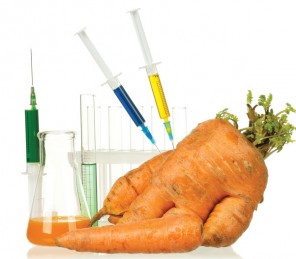By Staff Reporter
Simply speaking, transgenic is a process that transfers some genes in biological organism A to biological organism B, giving B some of the biological traits of A, such as resistance to insects, cold, drought, etc.; or the process that implants genes from bacteria into crops to make the plants produce toxins that will kill insect pests. After this process, the biological organism is referred to as a genetically modified (GM) organism.
GM crop production began in the United States in the early 1990s, and in 1999, it spread to China. In the early stages, transgenic crops seemed to reduce labor costs in weeding and the spraying of pesticides and herbicides. This enabled large-scale cultivation and the creation of giant seed monopolies. It spread rapidly after vigorous promotion by the biotech giants. Yet, these companies’ downplayed the damage GM crops could do to the ecological environment and the potential threat of GM foods on health.

Biologists had believed GM foods would be turned into small units in the human body through degeneration and digestion, similar to how traditional non-transgenic food consumption works. There was no distinction made in the safety of GM and non-GM foods. However, recent biological studies have shown that this is far from the truth.
In 2011, Professor Zhang Chenyu and his research team in Nanjing University published an article in Cell Research. They said they had found that plant microRNAs from daily food intake can enter the blood stream, body tissues and organs. In addition, through regulating the expression of the target gene, they can affect physiological functions in the human body. Numerous studies have shown that not all food’s genetic material is dissolved in the stomach and intestines. If some small unit in GM foods were absorbed by the body it could affect physiological functions and have disastrous consequences.
Currently, there is a lack of large-scale independent research into the safety of GM food. Yet some independent studies have pointed out that long-term consumption of GM may pose serious health hazards.
In 1998, Professor Árpád Pusztai from Rowett Research Institute in Scotland announced on television that one of his experimental studies demonstrated that rats fed with GM potatoes developed abnormal organs, had less body and organ weight, and damaged immune systems. These pups’ liver, heart, and brain were much smaller than normal and the immune system was more vulnerable. His paper was later published in the prestigious British medical journal The Lancet.
In 2006 , Russian scientist Dr. Irina Ermakova found that, more than half of the pups died in the first three weeks after birth, which is six times the baby mortality of mice fed with non GM soy beans. In addition, the surviving pups grew very slowly. Also, the female mice fed with GM soy beans had more aggression and anxiety symptoms, and some even lost their maternal instinct.
In 2011, a Canadian study found the transgenic Bacillus thuringiensis (or Bt) toxin in the blood samples of 28 out of 30 pregnant women. It was also discovered that 24 of the women had the toxin in their cord blood. In another non-pregnant group, 27 out of 39 women were found to have the toxins in their blood. Bt toxin is a pesticide residue implanted in cells of Bt GM corn and other crops via GM technology.
In 2012, Australian scientists proved that interspecies GM wheat contains altered proteins and enzyme inhibition mechanism, and the latter may lead to human liver failure, even death.

At present, almost all the research that lead to a harmless conclusion for GM food are those from, or funded by, biotech companies, and the longest study period only lasted 90 days. The lack of independent research in the safety of GM foods is not because scientists are not interested in it, but because it appears that the GM giants are stonewalling it. Scientific American has noted that several of their studies originally approved by the GM giants for print where later forbidden from being published. The GM companies used intellectual property rights to stop publication because they had negative results for GM food. The researchers were threatened with lawsuits if they persisted in publishing the results.
The above mentioned Professor Pusztai was a famous expert in his field. He had published more than 300 papers and 12 books. He was fired by the Rowett Research Institute, where he had worked for 35 years, because he published his research results. His research team was dismissed immediately.
Dr. Irina Ermakova had similar experience. After she reported her findings at a meeting, she was told by her supervisor to stop the experiment and her report was destroyed.
Because of this, most countries are very cautious of using GM food as a staple food. In the US, GM farm produce is usually used as animal feed in industrial material or exported. In 2012, a joint Chinese-American experimental group was exposed for using 24 six-to-eight year old children in Hunan province as subjects to test the effects of GM rice. The experiment was widely condemned by the international community and was immediately stopped.
In the campaign to promote GM crops, the GM giants often emphasize the benefits of GM crops on the environment. In reality, it is the opposite. In many countries, GM crops have been found to be harmful to the environment.
Because of excessive use of herbicides, weeds become more and more resistant to the chemicals, consequently, transgenic crops often need several times more chemicals than non-GM crops. Argentina is one of the countries around the world widely growing Monsanto’s Roundup Ready soybeans. The use of herbicides has soared to 300 million liters. In the article “Argentina’s Bad Seeds and GMO Crops,” Dr. Mercola describes a dialogue between a neonatal specialist and a filmmaker and it clearly exposes the consequence of excessive usage of Monsanto’s Roundup herbicide in Argentina:“…This doctor showed me a chart of two steeply climbing graphs, rising in tandem with each other — one representing the increase in soya plantations over the last 15 years; the other the rise in birth defects across the province during that same time. In the village of Malvinas Argentinas, which is surrounded by soy plantations, the rate of miscarriage is 100 times the national average, courtesy of glyphosate.”
In addition, the modified gene can be passed to genetically related species through hybridization that creates some new troubling species. In the U.S. and Canada, since a number of herbicide-resistant superweeds emerged due to the gene contamination of herbicide resistant GM crops, farmers there had to increase the application rates of herbicides. This vicious cycle has caused great harm to the environment.
Essentially, GM crops are new species introduced into the environment. A large-scale introduction of new species often causes an ecological system to lose its natural balance, which leads to the rupture of the original food chain. There are many lessons of this in history.

Monoculture caused by GM crop industrialization is also a potential threat to the entire web of life. Maintaining biodiversity is an important way to reduce the risk of invasion of epidemic diseases. The 1845 Ireland potato blight caused more than one million people to die of famine, and several million people were forced to emigrate out of Ireland. The reason was that only two potato species were planted in the country, and they were particularly vulnerable to the same disease. In the 1970s, the paddy straw virus occurred in Indonesia and India. Fortunately, one of 6,273 rice varieties was found to be resistant to the virus, and is now widely planted.
The biggest trouble for transgenic crop production is its irreversibility. Those who are in favor of GM cite that the FDA does not ban GM food and so GM food must be safe. However, one has to remember that in the past, there were many drugs and artificial foods passed by FDA inspectors which were later found to be harmful and banned after being used for decades. The most recent example is artificial trans fat. Fortunately, soon after the ban was imposed and the drugs and artificial foods were no longer being consumed, their side effects quickly disappeared. However, it is certainly not the case for transgenics. Due to hybridization contamination, GM crops may pass their modified genes to other plants. It is very difficult to control their spreading. Once genetic changes occur, it is almost impossible to recover. If transgenics are indeed proven to be harmful after decades of growth and consuming of GM foods, it will be an irreparable disaster to humankind.









Cancel anytime


Using our website
You may use the The Middle Land website subject to the Terms and Conditions set out on this page. Visit this page regularly to check the latest Terms and Conditions. Access and use of this site constitutes your acceptance of the Terms and Conditions in-force at the time of use.
Intellectual property
Names, images and logos displayed on this site that identify The Middle Land are the intellectual property of New San Cai Inc. Copying any of this material is not permitted without prior written approval from the owner of the relevant intellectual property rights.
Requests for such approval should be directed to the competition committee.
Please provide details of your intended use of the relevant material and include your contact details including name, address, telephone number, fax number and email.
Linking policy
You do not have to ask permission to link directly to pages hosted on this website. However, we do not permit our pages to be loaded directly into frames on your website. Our pages must load into the user’s entire window.
The Middle Land is not responsible for the contents or reliability of any site to which it is hyperlinked and does not necessarily endorse the views expressed within them. Linking to or from this site should not be taken as endorsement of any kind. We cannot guarantee that these links will work all the time and have no control over the availability of the linked pages.
Submissions
All information, data, text, graphics or any other materials whatsoever uploaded or transmitted by you is your sole responsibility. This means that you are entirely responsible for all content you upload, post, email or otherwise transmit to the The Middle Land website.
Virus protection
We make every effort to check and test material at all stages of production. It is always recommended to run an anti-virus program on all material downloaded from the Internet. We cannot accept any responsibility for any loss, disruption or damage to your data or computer system, which may occur while using material derived from this website.
Disclaimer
The website is provided ‘as is’, without any representation or endorsement made, and without warranty of any kind whether express or implied.
Your use of any information or materials on this website is entirely at your own risk, for which we shall not be liable. It is your responsibility to ensure any products, services or information available through this website meet your specific requirements.
We do not warrant the operation of this site will be uninterrupted or error free, that defects will be corrected, or that this site or the server that makes it available are free of viruses or represent the full functionality, accuracy and reliability of the materials. In no event will we be liable for any loss or damage including, without limitation, loss of profits, indirect or consequential loss or damage, or any loss or damages whatsoever arising from the use, or loss of data, arising out of – or in connection with – the use of this website.
Last Updated: September 11, 2024
New San Cai Inc. (hereinafter “The Middle Land,” “we,” “us,” or “our”) owns and operates www.themiddleland.com, its affiliated websites and applications (our “Sites”), and provides related products, services, newsletters, and other offerings (together with the Sites, our “Services”) to art lovers and visitors around the world.
This Privacy Policy (the “Policy”) is intended to provide you with information on how we collect, use, and share your personal data. We process personal data from visitors of our Sites, users of our Services, readers or bloggers (collectively, “you” or “your”). Personal data is any information about you. This Policy also describes your choices regarding use, access, and correction of your personal information.
If after reading this Policy you have additional questions or would like further information, please email at middleland@protonmail.com.
PERSONAL DATA WE COLLECT AND HOW WE USE IT
We collect and process personal data only for lawful reasons, such as our legitimate business interests, your consent, or to fulfill our legal or contractual obligations.
Information You Provide to Us
Most of the information Join Talents collects is provided by you voluntarily while using our Services. We do not request highly sensitive data, such as health or medical information, racial or ethnic origin, political opinions, religious or philosophical beliefs, trade union membership, etc. and we ask that you refrain from sending us any such information.
Here are the types of personal data that you voluntarily provide to us:
As a registered users or customers, you may ask us to review or retrieve emails sent to your business. We will access these emails to provide these services for you.
We use the personal data you provide to us for the following business purposes:
Information Obtained from Third-Party Sources
We collect and publish biographical and other information about users, which we use to promote the articles and our bloggers who use our sites. If you provide personal information about others, or if others give us your information, we will only use that information for the specific reason for which it was provided.
Information We Collect by Automated Means
Log Files
The site uses your IP address to help diagnose server problems, and to administer our website. We use your IP addresses to analyze trends and gather broad demographic information for aggregate use.
Every time you access our Site, some data is temporarily stored and processed in a log file, such as your IP addresses, the browser types, the operating systems, the recalled page, or the date and time of the recall. This data is only evaluated for statistical purposes, such as to help us diagnose problems with our servers, to administer our sites, or to improve our Services.
Do Not Track
Your browser or device may include “Do Not Track” functionality. Our information collection and disclosure practices, and the choices that we provide to customers, will continue to operate as described in this Privacy Policy, whether or not a “Do Not Track” signal is received.
HOW WE SHARE YOUR INFORMATION
We may share your personal data with third parties only in the ways that are described in this Privacy Policy. We do not sell, rent, or lease your personal data to third parties, and We does not transfer your personal data to third parties for their direct marketing purposes.
We may share your personal data with third parties as follows:
There may be other instances where we share your personal data with third parties based on your consent.
HOW WE STORE AND SECURE YOUR INFORMATION
We retain your information for as long as your account is active or as needed to provide you Services. If you wish to cancel your account, please contact us middleland@protonmail.com. We will retain and use your personal data as necessary to comply with legal obligations, resolve disputes, and enforce our agreements.
All you and our data are stored in the server in the United States, we do not sales or transfer your personal data to the third party. All information you provide is stored on a secure server, and we generally accepted industry standards to protect the personal data we process both during transmission and once received.
YOUR RIGHTS/OPT OUT
You may correct, update, amend, delete/remove, or deactivate your account and personal data by making the change on your Blog on www.themiddleland.com or by emailing middleland@protonmail.com. We will respond to your request within a reasonable timeframe.
You may choose to stop receiving Join Talents newsletters or marketing emails at any time by following the unsubscribe instructions included in those communications, or you can email us at middleland@protonmail.com
LINKS TO OTHER WEBSITES
The Middle Land include links to other websites whose privacy practices may differ from that of ours. If you submit personal data to any of those sites, your information is governed by their privacy statements. We encourage you to carefully read the Privacy Policy of any website you visit.
NOTE TO PARENTS OR GUARDIANS
Our Services are not intended for use by children, and we do not knowingly or intentionally solicit data from or market to children under the age of 18. We reserve the right to delete the child’s information and the child’s registration on the Sites.
PRIVACY POLICY CHANGES
We may update this Privacy Policy to reflect changes to our personal data processing practices. If any material changes are made, we will notify you on the Sites prior to the change becoming effective. You are encouraged to periodically review this Policy.
HOW TO CONTACT US
If you have any questions about our Privacy Policy, please email middleland@protonmail.com
The Michelin brothers created the guide, which included information like maps, car mechanics listings, hotels and petrol stations across France to spur demand.
The guide began to award stars to fine dining restaurants in 1926.
At first, they offered just one star, the concept was expanded in 1931 to include one, two and three stars. One star establishments represent a “very good restaurant in its category”. Two honour “excellent cooking, worth a detour” and three reward “exceptional cuisine, worth a
Thank you for your participation,
please Log in or Sign up to Vote

123Sign in to your account